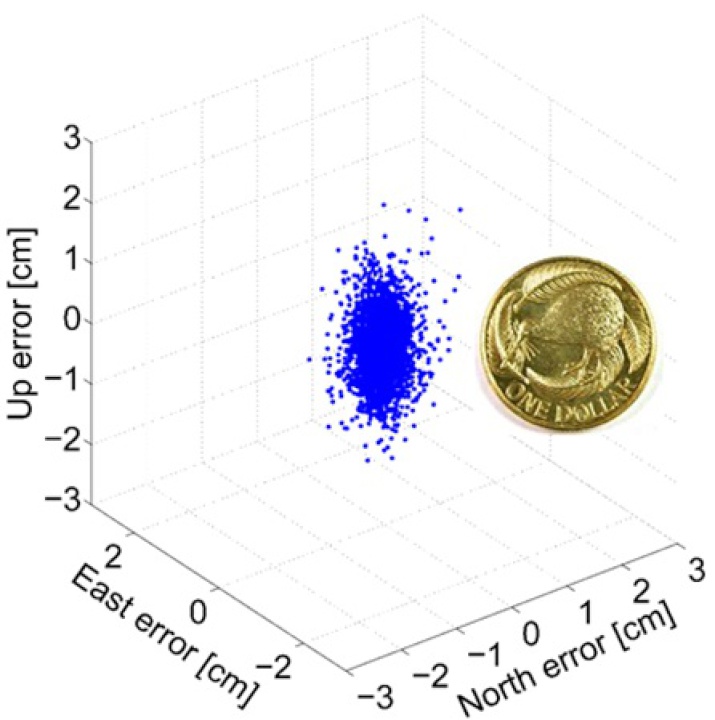Otago-led research set to make smartphones even smarter
Friday 31 August 2018
The accuracy of
the global positioning system (GPS) in smartphones has been
significantly improved thanks to research conducted at the
University of Otago, New Zealand, in collaboration with
Curtin University, Australia.
Have you ever noticed that the GPS location on your smartphone isn’t all that smart? For example, your smartphone claims you are in the duck pond when in fact you are on the other side of the park and can’t even see the duck pond? This new research conducted at the University of Otago, and recently published in the internationalJournal of Geodesy, is about to change that.
By combining signals from four different Global Navigation Satellite Systems (GNSSs), Otago’s Dr Robert Odolinski and Curtin University colleague Prof Peter Teunissen, have demonstrated that it is possible to achieve centimeter(CM)-level precise positioning on a smartphone.
“It’s all down to the mathematics we applied to make the most of the relatively low-cost technology smartphones use to receive GNSS signals, combining data from American, Chinese, Japanese, and European GNSS. We believe this new capability will revolutionize applications that require cm-level positioning,” Dr Odolinski says.
He says to understand the new technology, a look back at the historical scientific context is needed.
“For decades, construction, engineering, cadastral surveying and earthquake monitoring have relied on high-cost, ‘dual-frequency’, GPS positioning to obtaincentimetre-level location information. The challenge is that GPS signals, travelling from Earth-orbiting satellites to receivers on the ground, are disrupted along the way, and this generates errors and limiting precision. The traditional solution is to combine GPS signals sent at two different frequencies to improve the positions, but the antennas and receivers required have been expensive, far beyond the reach of many who would benefit from the technology,” says Dr Odolinski.
The new approach uses only one of two frequencies but collects data from more satellites, for what is called a “multi-constellation” GNSS solution. The extra data (and clever maths) is used to improve the positions without adding cost.
What Dr Odolinski and Prof Teunissen have now shown is that this approach can work in smartphones too, producing competitive results compared to dual-frequency GPS solutions (Figure 1).

Dr Odolinski believes that countries and industries of all sizes can benefit from using smartphones as GNSS receivers, and is confident commercial application and development will lead on from this research.
“This significant reduction in costs when using smartphones can increase the number of receivers that can be deployed, which will revolutionize a range of disciplines requiring centimetre-level positioning, including precise car navigation, surveying, and geophysics (deformation monitoring), to name a few.”
Read the full research paper: (upon clicking the link an error code may show, however an option to proceed will follow)
https://link.springer.com/content/pdf/10.1007%2Fs00190-018-1192-5.pdf
ends


 Primeproperty Group: Primeproperty Group Purchases The Reading Cinema Complex & Adjoining Car Parking Properties in the heart of Wellington's Courtenay Place
Primeproperty Group: Primeproperty Group Purchases The Reading Cinema Complex & Adjoining Car Parking Properties in the heart of Wellington's Courtenay Place Hugh Grant: Lessons From Australia - How Digital Tools Could Support NZ Nurses In Palliative Care
Hugh Grant: Lessons From Australia - How Digital Tools Could Support NZ Nurses In Palliative Care Canterbury Museum: Dinosaur Dolphins Survived In New Zealand Long After Extinction Elsewhere
Canterbury Museum: Dinosaur Dolphins Survived In New Zealand Long After Extinction Elsewhere Retail NZ: Retailers Still Under Pressure At End Of 2024
Retail NZ: Retailers Still Under Pressure At End Of 2024  University of Canterbury: Research Sheds Light On Fire Risk For Canterbury
University of Canterbury: Research Sheds Light On Fire Risk For Canterbury GE Free NZ: Potential $20 Billion Loss In Export Demand Threatens Rural Communities
GE Free NZ: Potential $20 Billion Loss In Export Demand Threatens Rural Communities



